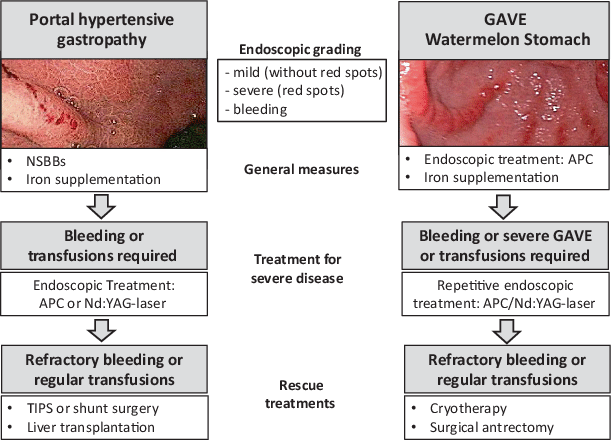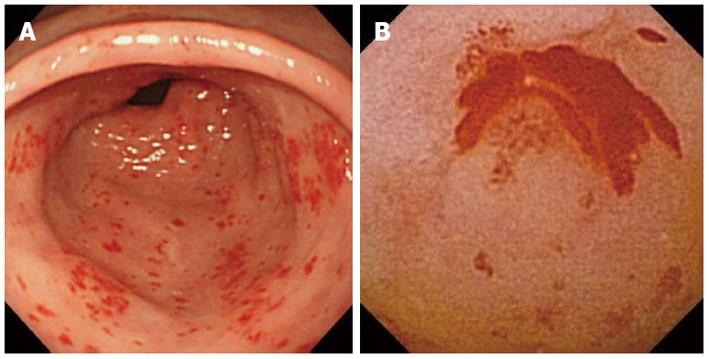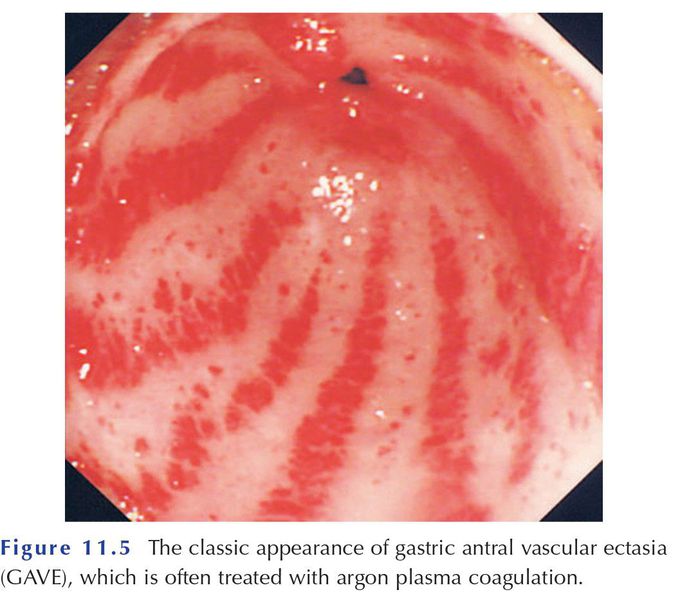Your Gastric antral vascular ectasia with bleeding images are ready in this website. Gastric antral vascular ectasia with bleeding are a topic that is being searched for and liked by netizens today. You can Find and Download the Gastric antral vascular ectasia with bleeding files here. Download all free photos.
If you’re looking for gastric antral vascular ectasia with bleeding pictures information related to the gastric antral vascular ectasia with bleeding topic, you have pay a visit to the ideal blog. Our website always gives you hints for seeing the maximum quality video and image content, please kindly hunt and locate more informative video articles and images that fit your interests.
Gastric Antral Vascular Ectasia With Bleeding. GAVE causes chronic occult bleeding resulting in iron-deficiency anemia. 14 Although it is associated with heterogeneous medical conditions including hepatic renal and cardiac diseases its pathogenesis is unknown. Gastric antral vascular ectasia GAVE syndrome also known as watermelon stomach is a rare but significant cause of severe acute or chronic gastrointestinal blood loss in the elderly. It is often associated with systemic diseases such as autoimmune diseases liver cirrhosis chronic renal insufficiency and cardiovascular disease.
 Gastric Antral Vascular Ectasia An Uncommon Cause Of Gi Bleeding Semantic Scholar From semanticscholar.org
Gastric Antral Vascular Ectasia An Uncommon Cause Of Gi Bleeding Semantic Scholar From semanticscholar.org
13 The diagnosis of GAVE syndrome in. Common symptoms reported by people with gastric antral vascular ectasia. We present two cases of GAVE one with pernicious anaemia associated and the other is portal hypertension related. The diagnosis is mainly based on endoscopic pattern and for uncertain cases on histology. It can be associated with long-term chronic diseases such as cirrhosis of the liver. 14 Although it is associated with heterogeneous medical conditions including hepatic renal and cardiac diseases its pathogenesis is unknown.
It is often associated with systemic diseases such as autoimmune diseases liver cirrhosis chronic renal insufficiency and cardiovascular disease.
Introduction Gastric antral vascular ectasia GAVE is a rare disorder characterised by upper GI bleeding chronic iron-deficiency anaemia and endoscopic findings of columns of red tortuous vessels along the longitudinal folds of the antrum of the stomach. Typical lesions of GAVE are striped radiating from. Gastric Antral Vascular Ectasia GAVE is a rare condition that causes severe acute or chronic gastrointestinal bleeding especially in the elderly and in women. GAVE is characterized by a pathognomonic endoscopic pattern mainly. Gastric antral vascular ectasia GAVE is a capillary-type vascular malformation located primarily in the gastric antrum. The diagnosis is typically made based on the characteristic endoscopic features including longitudinal row of flat reddish stripes radiating from the pylorus into the antrum that resemble the stripes on a watermelon.
 Source: educationaldimensions.com
Source: educationaldimensions.com
This blood loss may lead to iron deficiency anemia. Gastric antral vascular ectasia GAVE has been recognized as one of the important causes of occult and obscure gastrointestinal bleeding. Its most commonly seen in older adults especially women. Although the pathogenesis of this condition is largely unknown it is associated with a number of medical. The diagnosis is typically made based on the characteristic endoscopic features including longitudinal row of flat reddish stripes radiating from the pylorus into the antrum that resemble the stripes on a watermelon.
Source: encrypted-tbn0.gstatic.com
Gastric antral vascular ectasia GAVE is an uncommon cause of upper gastrointestinal bleeding. Patients with GAVE are most frequently elderly women. This blood loss may lead to iron deficiency anemia. We present two cases of GAVE one with pernicious anaemia associated and the other is portal hypertension related. The etiology of GAVE has not been fully explored and remains controversial.
 Source: epainassist.com
Source: epainassist.com
This report describes 5 patients with systemic sclerosis SSc who developed severe recurrent upper gastrointestinal GI bleeding due to gastric antral vascular ectasia GAVE. GAVE causes chronic occult bleeding resulting in iron-deficiency anemia. Treatment of GAVE with endoscopic thermal therapy ETT requires multiple sessions for destruction of vascular ectasia and control of bleeding. We present two cases of GAVE one with pernicious anaemia associated and the other is portal hypertension related. Gastric antral vascular ectasia GAVE has been recognized as one of the important causes of occult and obscure gastrointestinal bleeding.
 Source: researchgate.net
Source: researchgate.net
Its most commonly seen in older adults especially women. Gastric antral vascular ectasia is a fairly rare cause of internal bleeding. Patients with GAVE are most frequently elderly women. Gastric antral vascular ectasia GAVE is a rare but an important cause of upper gastrointestinal bleeding UGIB and commonly presents as occult bleeding that manifests as. The diagnosis is typically made based on the characteristic endoscopic features including longitudinal row of flat reddish stripes radiating from the pylorus into the antrum that resemble the stripes on a watermelon.
 Source: thompsoncancer.com
Source: thompsoncancer.com
Gastric antral vascular ectasia GAVE is a capillary-type vascular malformation located primarily in the gastric antrum. Our presentation at the American College of Rheumatologys 2015 meeting detailed the intriguing results of our small retrospective study that may provide hope for preventing recurrent bleeding episodes in GAVE. Gastric antral vascular ectasia GAVE is an uncommon but often severe cause of upper gastrointestinal GI bleeding responsible of about 4 of non-variceal up-. Gastric antral vascular ectasia GAVE syndrome is an uncommon cause of chronic gastrointestinal bleeding as well as iron deficiency anaemia. What is gastric antral vascular ectasia.
 Source: middleeastmedicalportal.com
Source: middleeastmedicalportal.com
It is one of the diagnoses to consider in older patients with severe anemia and occult or profuse gastrointestinal bleeding especially in those with cardiac liver or. The diagnosis is mainly based on endoscopic pattern and for uncertain cases on histology. Gastric antral vascular ectasia GAVE is an uncommon but often severe cause of upper gastrointestinal GI bleeding responsible of about 4 of non-variceal up-. Gastric antral vascular ectasia GAVE is also known as watermelon stomach because of its common endoscopic appearance. The etiology of GAVE has not been fully explored and remains controversial.
 Source: link.springer.com
Source: link.springer.com
What is gastric antral vascular ectasia. Gastric antral vascular ectasia GAVE syndrome also known as watermelon stomach is a rare but significant cause of severe acute or chronic gastrointestinal blood loss in the elderly. It is one of the diagnoses to consider in older patients with severe anemia and occult or profuse gastrointestinal bleeding especially in those with cardiac liver or. Gastric Antral Vascular Ectasia. Gastric antral vascular ectasia GAVE is characterized by mucosal and submucosal vascular ectasia causing recurrent GI hemorrhage.
 Source: wjgnet.com
Source: wjgnet.com
Gastric Antral Vascular Ectasia GAVE is a rare condition that causes severe acute or chronic gastrointestinal bleeding especially in the elderly and in women. Gastric antral vascular ectasia GAVE syndrome also known as watermelon stomach is a rare but significant cause of severe acute or chronic gastrointestinal blood loss in the elderly. Since its first report by Rider et al. GAVE causes chronic occult bleeding resulting in iron-deficiency anemia. Gastric Antral Vascular Ectasia.
 Source: researchgate.net
Source: researchgate.net
Gastric antral vascular ectasia GAVE is a rare cause of chronic bleeding in cirrhotic patients. The etiology of GAVE has not been fully explored and remains controversial. Gastric antral vascular ectasia often results in chronic gastrointestinal bleeding with few options for effective treatment. The diagnosis is mainly based on endoscopic pattern and for uncertain cases on histology. The Halo 90 system has been newly approved for this indication.

Gastric antral vascular ectasia GAVE is a rare cause of chronic bleeding in cirrhotic patients. Autoimmune diseases such as hardening and scarring of the skin scleroderma. The diagnosis is mainly based on endoscopic pattern and for uncertain cases on histology. Gastric antral vascular ectasia GAVE is a rare but an important cause of upper gastrointestinal bleeding UGIB and commonly presents as occult bleeding that manifests as. Our presentation at the American College of Rheumatologys 2015 meeting detailed the intriguing results of our small retrospective study that may provide hope for preventing recurrent bleeding episodes in GAVE.
 Source: msdmanuals.com
Source: msdmanuals.com
Introduction Gastric antral vascular ectasia GAVE is a rare disorder characterised by upper GI bleeding chronic iron-deficiency anaemia and endoscopic findings of columns of red tortuous vessels along the longitudinal folds of the antrum of the stomach. Since its first report by Rider et al. It can be associated with long-term chronic diseases such as cirrhosis of the liver. It is often associated with systemic diseases such as autoimmune diseases liver cirrhosis chronic renal insufficiency and cardiovascular disease. The diagnosis is mainly based on endoscopic pattern and for uncertain cases on histology.
 Source: uptodategastro.wordpress.com
Source: uptodategastro.wordpress.com
It is often associated with systemic diseases such as autoimmune diseases liver cirrhosis chronic renal insufficiency and cardiovascular disease. Gastric antral vascular ectasia GAVE syndrome also known as watermelon stomach is a rare but significant cause of severe acute or chronic gastrointestinal blood loss in the elderly. Since its first report by Rider et al. GAVE is characterized by a pathognomonic endoscopic pattern mainly. Treatment of GAVE with surgical or nonsurgical portal decompression β-blockers or endoscopic therapy provides disappointing results.

The diagnosis is typically made based on the characteristic endoscopic features including longitudinal row of flat reddish stripes radiating from the pylorus into the antrum that resemble the stripes on a watermelon. Patients with GAVE are most frequently elderly women. Gastric antral vascular ectasia GAVE syndrome also known as watermelon stomach is a rare but significant cause of severe acute or chronic gastrointestinal blood loss in the elderly. Patients can present with iron-deficiency anemia overt gastrointestinal bleeding or both. Gastric antral vascular ectasia GAVE has been recognized as one of the important causes of occult and obscure gastrointestinal bleeding.
 Source: sciencephoto.com
Source: sciencephoto.com
Its most commonly seen in older adults especially women. It is one of the diagnoses to consider in older patients with severe anemia and occult or profuse gastrointestinal bleeding especially in those with cardiac liver or. Gastric antral vascular ectasia GAVE is an uncommon but important cause of chronic gastrointestinal bleeding. Diagnosis and characterization is made at endoscopic examination and the preferred management of patients with GAVE is endoscopic. 14 Although it is associated with heterogeneous medical conditions including hepatic renal and cardiac diseases its pathogenesis is unknown.
 Source: researchgate.net
Source: researchgate.net
Treatment of GAVE with endoscopic thermal therapy ETT requires multiple sessions for destruction of vascular ectasia and control of bleeding. Gastric antral vascular ectasia GAVE is also known as watermelon stomach because of its common endoscopic appearance. Gastric antral vascular ectasia GAVE is an uncommon cause of upper gastrointestinal bleeding. 14 Although it is associated with heterogeneous medical conditions including hepatic renal and cardiac diseases its pathogenesis is unknown. Our presentation at the American College of Rheumatologys 2015 meeting detailed the intriguing results of our small retrospective study that may provide hope for preventing recurrent bleeding episodes in GAVE.
 Source: wikiwand.com
Source: wikiwand.com
What is gastric antral vascular ectasia. In 1953 1 GAVE has been increasingly recognized. Gastric antral vascular ectasia GAVE is an uncommon but often severe cause of upper gastrointestinal GI bleeding responsible of about 4 of non-variceal upper GI haemorrhage. Our presentation at the American College of Rheumatologys 2015 meeting detailed the intriguing results of our small retrospective study that may provide hope for preventing recurrent bleeding episodes in GAVE. We present two cases of GAVE one with pernicious anaemia associated and the other is portal hypertension related.
 Source: researchgate.net
Source: researchgate.net
Although the pathogenesis of this condition is largely unknown it is associated with a number of medical. Gastric antral vascular ectasia GAVE is an uncommon cause of upper gastrointestinal bleeding. The clinical records the endoscopic findings and the histologic appearance of biopsy specimens and surgically resected gastric tissue from the patients were reviewed. GAVE causes chronic occult bleeding resulting in iron-deficiency anemia. The Halo 90 system has been newly approved for this indication.
 Source: semanticscholar.org
Source: semanticscholar.org
Gastric antral vascular ectasia GAVE is a rare but an important cause of upper gastrointestinal bleeding UGIB and commonly presents as occult bleeding that manifests as. Gastric antral vascular ectasia GAVE is an uncommon but often severe cause of upper gastrointestinal GI bleeding responsible of about 4 of non-variceal up-. Common symptoms reported by people with gastric antral vascular ectasia. Patients with GAVE are most frequently elderly women. In 1953 1 GAVE has been increasingly recognized.
This site is an open community for users to do sharing their favorite wallpapers on the internet, all images or pictures in this website are for personal wallpaper use only, it is stricly prohibited to use this wallpaper for commercial purposes, if you are the author and find this image is shared without your permission, please kindly raise a DMCA report to Us.
If you find this site value, please support us by sharing this posts to your favorite social media accounts like Facebook, Instagram and so on or you can also save this blog page with the title gastric antral vascular ectasia with bleeding by using Ctrl + D for devices a laptop with a Windows operating system or Command + D for laptops with an Apple operating system. If you use a smartphone, you can also use the drawer menu of the browser you are using. Whether it’s a Windows, Mac, iOS or Android operating system, you will still be able to bookmark this website.







